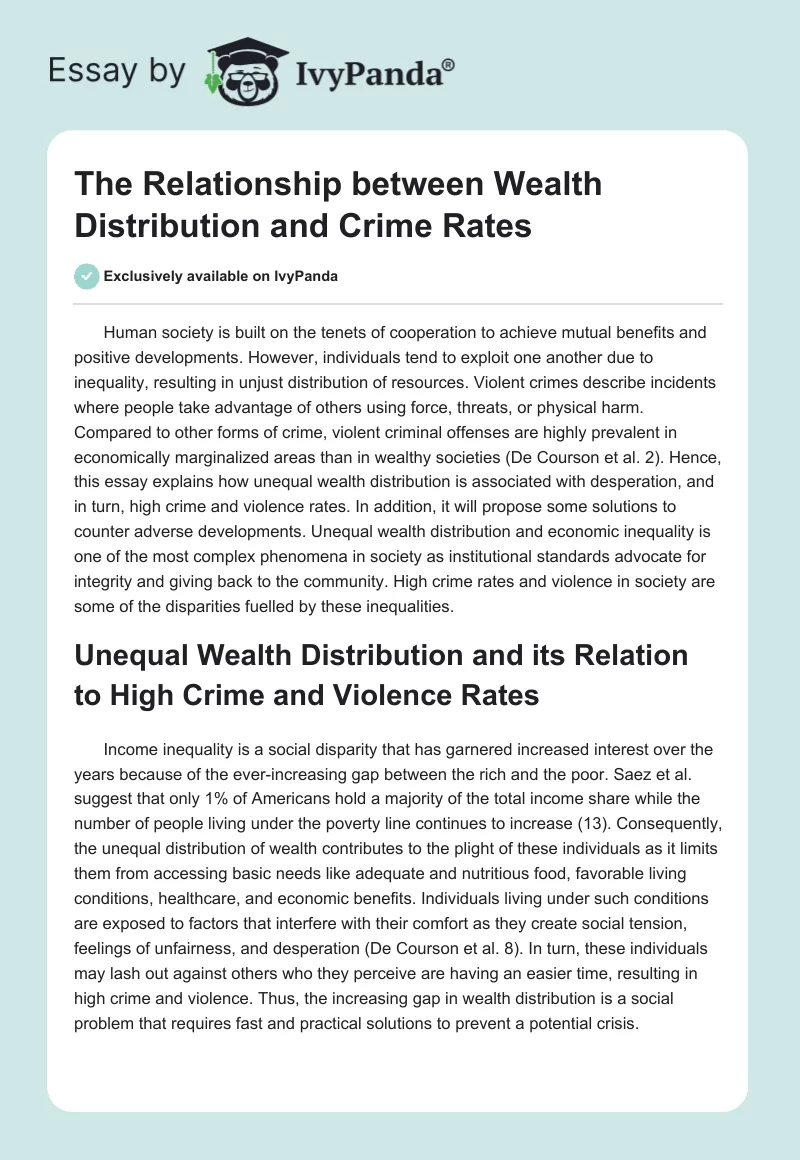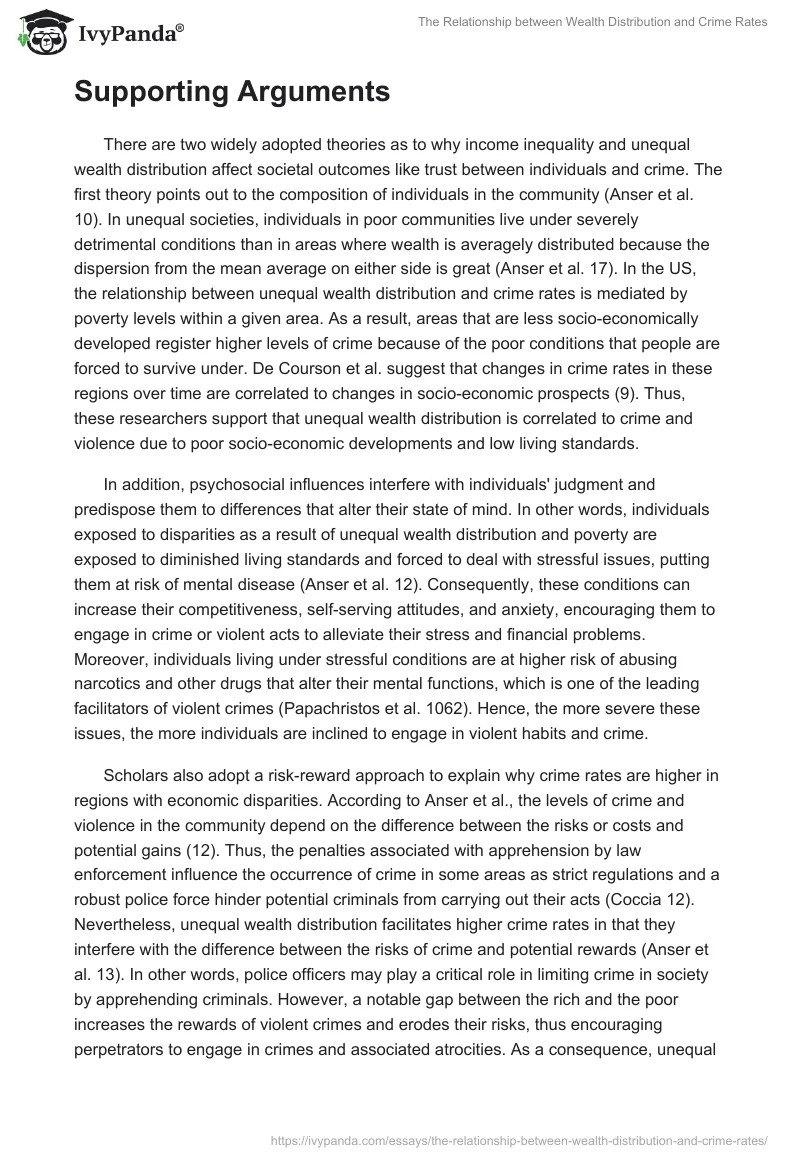Human society is built on the tenets of cooperation to achieve mutual benefits and positive developments. However, individuals tend to exploit one another due to inequality, resulting in unjust distribution of resources. Violent crimes describe incidents where people take advantage of others using force, threats, or physical harm. Compared to other forms of crime, violent criminal offenses are highly prevalent in economically marginalized areas than in wealthy societies (De Courson et al. 2). Hence, this essay explains how unequal wealth distribution is associated with desperation, and in turn, high crime and violence rates. In addition, it will propose some solutions to counter adverse developments. Unequal wealth distribution and economic inequality is one of the most complex phenomena in society as institutional standards advocate for integrity and giving back to the community. High crime rates and violence in society are some of the disparities fuelled by these inequalities.
Unequal Wealth Distribution and its Relation to High Crime and Violence Rates
Income inequality is a social disparity that has garnered increased interest over the years because of the ever-increasing gap between the rich and the poor. Saez et al. suggest that only 1% of Americans hold a majority of the total income share while the number of people living under the poverty line continues to increase (13). Consequently, the unequal distribution of wealth contributes to the plight of these individuals as it limits them from accessing basic needs like adequate and nutritious food, favorable living conditions, healthcare, and economic benefits. Individuals living under such conditions are exposed to factors that interfere with their comfort as they create social tension, feelings of unfairness, and desperation (De Courson et al. 8). In turn, these individuals may lash out against others who they perceive are having an easier time, resulting in high crime and violence. Thus, the increasing gap in wealth distribution is a social problem that requires fast and practical solutions to prevent a potential crisis.
Supporting Arguments
There are two widely adopted theories as to why income inequality and unequal wealth distribution affect societal outcomes like trust between individuals and crime. The first theory points out to the composition of individuals in the community (Anser et al. 10). In unequal societies, individuals in poor communities live under severely detrimental conditions than in areas where wealth is averagely distributed because the dispersion from the mean average on either side is great (Anser et al. 17). In the US, the relationship between unequal wealth distribution and crime rates is mediated by poverty levels within a given area. As a result, areas that are less socio-economically developed register higher levels of crime because of the poor conditions that people are forced to survive under. De Courson et al. suggest that changes in crime rates in these regions over time are correlated to changes in socio-economic prospects (9). Thus, these researchers support that unequal wealth distribution is correlated to crime and violence due to poor socio-economic developments and low living standards.
In addition, psychosocial influences interfere with individuals’ judgment and predispose them to differences that alter their state of mind. In other words, individuals exposed to disparities as a result of unequal wealth distribution and poverty are exposed to diminished living standards and forced to deal with stressful issues, putting them at risk of mental disease (Anser et al. 12). Consequently, these conditions can increase their competitiveness, self-serving attitudes, and anxiety, encouraging them to engage in crime or violent acts to alleviate their stress and financial problems. Moreover, individuals living under stressful conditions are at higher risk of abusing narcotics and other drugs that alter their mental functions, which is one of the leading facilitators of violent crimes (Papachristos et al. 1062). Hence, the more severe these issues, the more individuals are inclined to engage in violent habits and crime.
Scholars also adopt a risk-reward approach to explain why crime rates are higher in regions with economic disparities. According to Anser et al., the levels of crime and violence in the community depend on the difference between the risks or costs and potential gains (12). Thus, the penalties associated with apprehension by law enforcement influence the occurrence of crime in some areas as strict regulations and a robust police force hinder potential criminals from carrying out their acts (Coccia 12). Nevertheless, unequal wealth distribution facilitates higher crime rates in that they interfere with the difference between the risks of crime and potential rewards (Anser et al. 13). In other words, police officers may play a critical role in limiting crime in society by apprehending criminals. However, a notable gap between the rich and the poor increases the rewards of violent crimes and erodes their risks, thus encouraging perpetrators to engage in crimes and associated atrocities. As a consequence, unequal wealth distribution can lead to higher crime regardless of law enforcement efforts to limit criminal activities.
Counterarguments
Some individuals hold that unequal wealth distribution does not increase crime rates. Instead, several factors come into play, thus encouraging individuals to engage in violent crimes. According to Imran et al., a wealth of literature points to income inequality as the main facilitator of violent crime. Nevertheless, researchers fail to acknowledge the impact of income levels, and poverty rather than income inequality (54). The researchers argue that cross-national studies investigating crimes like homicide fail to control variables like poverty, which is one of the most notable predictors of crime in the US. Although there is evidence to support a relationship between crime rates and income inequality, critical studies using similar data sets proclaim that income inequality is insignificant when poverty is aggregated in the regression model (Imran et al. 69). Thus, these studies purport that poverty levels should be used to explain violent crime rates and not income inequality.
Similarly, scholars suggest that criminals in society are less intelligent than others who choose to stay away from crime, which translates to their IQ and education levels. According to Odabaşi, low intelligence and poor performance in school are indicators of future criminal behavior since they predispose individuals to factors like stress, depression, drug abuse, and high-pressure environments (1224). People’s educational achievement is related to their intelligence quotient (IQ) as individuals with low IQ are unlikely to comprehend the consequences of their actions. Similarly, the US Department of Justice reports that a typical criminal in the US, from data collected in prison facilities, is unemployed, under-educated, and lives in poverty (Odabaşi 1242). Hence, researchers attribute high crime rates to low IQ, associated with poor educational performance.
Refutation
Although poverty and low IQ are reasonable arguments to support that unequal wealth distribution is not correlated to violent crimes, it is critical to alter the perspective and acknowledge the main cause of these disparities. Unequal wealth distribution results in economic inequalities that disadvantage individuals receiving minimum wages and the unemployed. To put it in another way, individuals controlling vast amounts of wealth have access to additional resources and high-quality services due to their high living standards. On the other hand, populations that have access to minimum resources struggle to make ends meet and only prioritize critical issues in their societies (Coccia 16). As a result, they lose out on quality educational opportunities, resulting in high levels of unemployment and substandard living. Subsequently, these factors facilitate their negative and impulsive behaviors towards others.
Recommendations
Reducing violent crime rates in marginalized communities is a challenging task for law enforcement personnel. Judging by the number of individuals incarcerated for violent crimes like robbery, assault, and murder, the situation is getting worse as prisons are overwhelmed. Although instilling fear in would-be criminals by implementing stern regulations and reparations against violent crimes can help deter its prevalence, these solutions are short-term as they do not provide people in the community with the motivation to change their ways (Hazra et al. 32). Therefore, the most practical solution is to empower individuals in these communities by providing them with the resources they need to develop. Inequality and marginalization are vices deeply rooted in human society. Thus, it is essential to address these issues and establish solutions to lend a hand to the disabled, marginalized communities, and individuals living under the poverty line.
Focusing on remuneration policies can also help the government to channel more money into marginalized areas. Most CEOs and top officials in the US receive abnormally high salaries, coupled with absurd organizational benefits (Saez et al 14). On the other hand, individuals who engage with vital organizational processes, low-level employees, and subordinate staff walk home with insufficient pay (Hazra et al. 48). Unequal wealth distribution alleviates individuals’ levels of poverty as the employed people, responsible for the region’s economic stability and continuous advancement, do not have sufficient access to finances and resources (Anser et al. 11). Therefore, revisiting remuneration policies to provide all workers with reasonable pay according to their employment structures, incentives, and benefits like additional healthcare coverage can help alleviate their issues and allow them to support economic development in their areas.
Conclusion
Economic inequality is characterized by complex facets as it goes against human and organizational standards advocating for integrity and community development. High crime rates and violence are fuelled by these inequalities, resulting in higher number of cases in marginalized areas. These inequalities are propelled by factors like discrimination, racism, a wide income gap, the lack of education opportunities, unemployment, and the negligence of leaders and the government. In turn, some people struggle to make ends meet while others have excess money to spend. Unequal wealth distribution has social and psychological implications as it contributes to feelings of unfairness, encouraging suffering people to retaliate. Moreover, it exposes individuals to poor living conditions and detrimental factors that interfere with their judgment. As a result, these individuals occasionally engage in violent crimes, thus driving up crime rates in these areas. Nevertheless, empowering these individuals to access better educational and personal development opportunities can facilitate improvement and diminish crime. Similarly, revising remuneration policies to provide middle-class individuals and employed workers financing opportunities will allow them to spend more on development. Nevertheless, addressing social issues like racism, discrimination, and marginalization is the first step toward achieving equality.
Works Cited
Anser, Muhammad Khalid, et al., “Dynamic linkages between poverty, inequality, crime, and social expenditures in a panel of 16 countries: two-step GMM estimates.”Journal of Economic Structures, vol. 9, no. 1, 2020, pp. 1-25. Web.
Coccia, Mario. “Economic inequality can generate unhappiness that leads to violent crime in society.”International Journal of Happiness and Development, vol. 4, no. 1, 2018, pp. 1-24. Web.
De Courson, Benoît, and Daniel Nettle. “Why do inequality and deprivation produce high crime and low trust?”Scientific Reports, vol. 11, no. 1, 2021, pp. 1-11. Web.
Hazra, Devika, and Jose Aranzazu. “Crime, correction, education, and welfare in the US–What role does the government play?”Journal of Policy Modeling, vol. 44, no. 2 2022, pp. 474-491. Web.
Imran, Mohammed, et al. “Does poverty lead to crime? Evidence from the United States of America.”International Journal of Social Economics, vol. 45, no. 10, 2018, pp. 1424-1438. Web.
Odabaşi, Suzan. “Mental wellbeing and economics of crime: A county-level analysis in the US.”Yaşar Üniversitesi E-Dergisi, vol. 16, no. 63, 2021, pp. 1218-1236. Web.
Papachristos, Andrew V. et al. “Understanding the crime gap: Violence and inequality in an American city.”City & Community, vol. 17, no. 4, 2018, pp. 1051-1074. Web.
Saez, Emmanuel, and Gabriel Zucman. “The rise of income and wealth inequality in America: evidence from distributional macroeconomic accounts.”Journal of Economic Perspectives, vol. 34, no. 4, 2020, pp. 3-26. Web.


